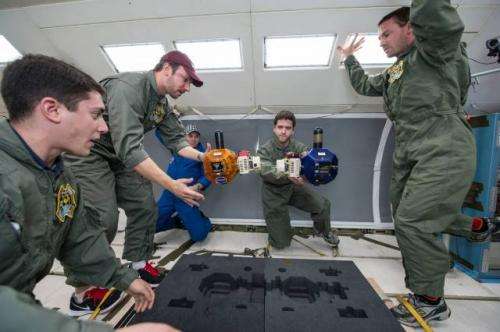With NASA's help, AeroAstro students work in a space-like environment

For a team of MIT Aeronautics and Astronautics students, research isn't a weighty matter—in fact, there's virtually no weight at all.
That's because their experiments took place late this summer in an almost weightless environment aboard NASA's reduced gravity aircraft, a modified Boeing 727-200 that, by following an approximately parabolic flight path, offers brief periods of weightlessness.
Under the auspices of the Department of Aeronautics and Astronautics' Space Systems Lab, the student team tested advanced space instruments that could be installed on SPHERES (Synchronized Position Hold, Engage, Reorient, Experimental Satellites), MIT-designed basketball-size satellites that are used aboard the International Space Station to test autonomy, control, and formation flight algorithms.
One of the devices tested was Halo, a structure shaped like a Star Wars TIE fighter, that lets SPHERES operate a variety of new payloads. One such payload is a docking port which, when installed, allows multiple SPHERES to physically connect and disconnect from each other, enabling them to assemble in a variety of reconfigurable formations. Research applications of the formation flight ability include on-orbit satellite servicing, orbital debris removal, and creation of fractionated space systems where the functional capabilities traditionally assigned to a single large satellite are divided among multiple satellites operating in unison.
Aboard the reduced gravity aircraft, the MIT team used these devices to demonstrate satellite docking and undocking in six degrees of freedom. The docking port and Halo were designed and built by students in the Space Systems Lab in conjunction with engineers from Aurora Flight Sciences.
SPHERES INSPECT, the subject of last year's AeroAstro capstone class, was another set of instruments tested by the students. INSPECT provides SPHERES with a suite of high-precision pointing sensors. The data from a thermo-imager, a lidar, and stereo vision cameras can be combined by SPHERES, allowing the satellites to inspect unknown or damaged space objects. A quad of control moment gyros uses this data to give the necessary pointing control accuracy.
The reduced-gravity aircraft follows an approximately parabolic elliptic flight path relative to the Earth's center. NASA provided the team with 330 parabolas for a total of 2.5 hours weightless data collection.
SPHERES were initially designed by capstone class students. The three SPHERES aboard the space station support a variety of cutting-edge space technologies experiments. They are also the focus of the annual Zero Robotics competition in which middle school and high school students around the world compete in the design and execution of programs for the satellites to execute.
Provided by Massachusetts Institute of Technology
This story is republished courtesy of MIT News (web.mit.edu/newsoffice/), a popular site that covers news about MIT research, innovation and teaching.





















